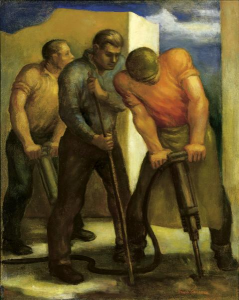
Biography
At age 19, Frank Cassara was peeking into the work area at the Detroit Institute of Arts, where Diego Rivera was painting his Detroit Industry murals. Not many years later he was painting his own murals - at the Water Conditioning Plant in Lansing, MI, at Thompson Elementary School in Highland Park, MI, and two Post Office murals. His art training was at the Detroit School of Art under Walter Speck and Reginald Bennett, and he studied fresco technique with Jean Paul Slusser. By 1938 he had obtained an appointment as supervisor for easel painting of the Michigan section of the Federal Art Project.Following the Second World War, Cassara began a teaching career at the University of Michigan, which lasted from 1947 to 1983 and influenced the careers of hundreds of artists. After spending time in Paris in 1958 studying printmaking, he focused primarily on this area.


Critical Analysis
Cassara's paintings in the 1930s were typical of that era - with heroic workers in demanding occupations. But his work had a compelling earnestness. His real contribution to the art world lay in his teaching and his relentless exploration of methods and materials. In 1963, for example, he published a description of an innovative white etching ground. And in the 1970s he experimented with photogenic drawing, where images are produced by drawing on photographic paper with photographic developer or other chemicals.Murals
- Eastpointe, Michigan - Post Office: Early Settlers
- Lansing, Michigan - Board of Water and Light Dye Conditioning Plant: Beneficial Force of Water
- Lansing, Michigan - Board of Water and Light Dye Conditioning Plant: Water As Destructive Element
- Sandusky, Michigan - Post Office: Cattle Auctions
References
- Artist Biographies (New Deal Art and Architecture).
- Frank Cassara (Smithsonian American Art Museum).
- Frank Cassara – Last of the New Deal CCC artists (New Deal Stories).
- Frank Cassara: 1913 - 2017 (Stamps School of Art and Design).
- dcollins, Saluting Frank Cassara, nonfigurative photo June 12 (2015).